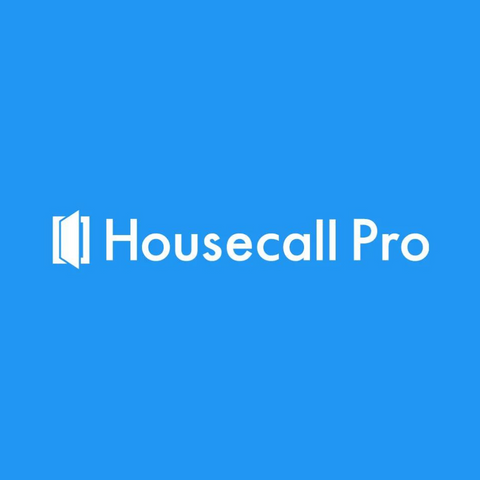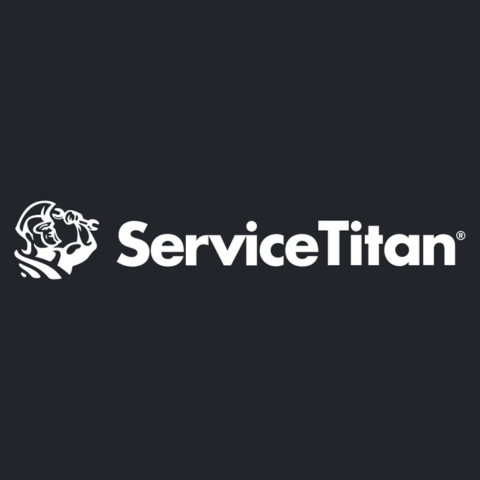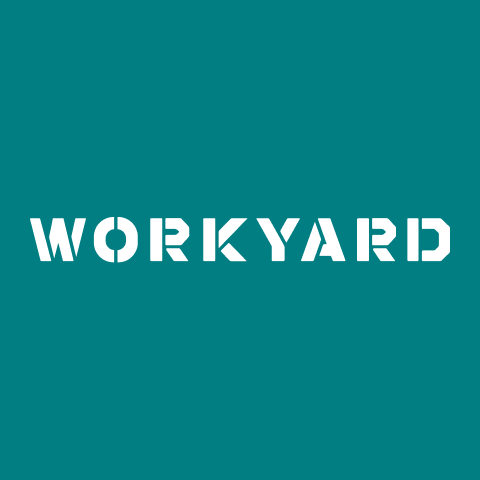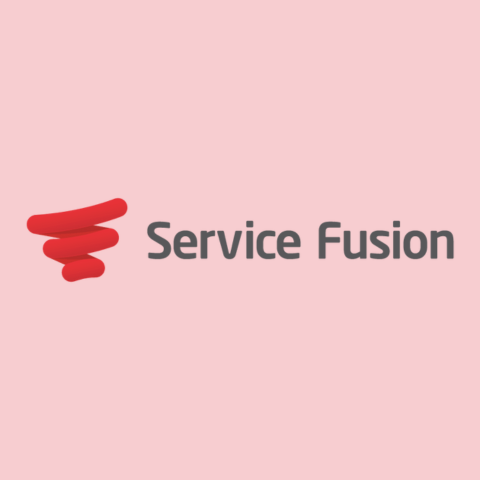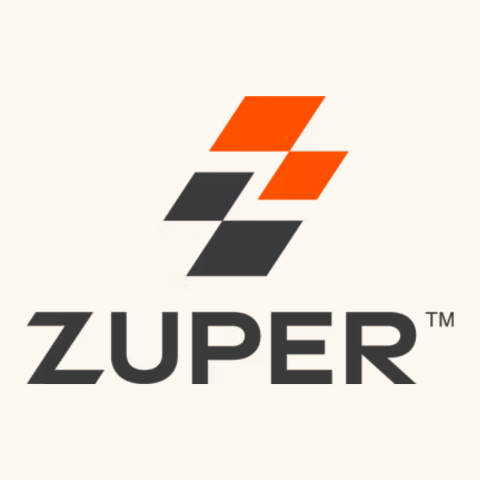Anyone managing HVAC (Heating, Ventilation, and Air Conditioning) service business is completely aware of its pain points: missed bookings, delayed payments, inaccurate job costing, and poor communication between field technicians and office staff.
You can say goodbye to these inconveniences by using HVAC software. This application is designed to automate the operations of HVAC business with scheduling, dispatching, invoicing, customer management, inventory tracking, and reporting.
Besides improving the efficiency of your field workforce, it improves collaboration between technicians and office staff while ensuring better customer satisfaction. After researching 20 HVAC software programs, here are my best picks for this category.
- 1. Housecall Pro – All-in-one to boost customer bookings
- 2. Jobber – Quote-to-payment for growing service businesses
- 3. ServiceTitan – Best for large-scale HVAC businesses
- 4. FieldEdge – Best to optimize field operations
- 5. Workyard – Inbuilt GPS tracking and payroll
- 6. Service Fusion – Integrated field service management
- 7. Zuper – Flexible FSM for small businesses
- 8. FieldPulse – Residential HVAC software
- 9. Zoho FSM – Affordable HVAC software for small teams
- Show less
HVAC Software Comparison
Below is a comparison table to see where the HVAC software applications stand in terms of major features such as scheduling, mobile app, inventory management, and pricing.
Here is the detailed discussion on the top HVAC software.
1. Housecall Pro
All-in-one to boost customer bookings
Housecall Pro claims to help you save 8+ hours weekly in job scheduling and invoicing by switching to their platform[1]. From scheduling jobs to getting paid, the platform makes things a lot simpler by allowing you to perform all tasks from one place in an organized manner.
Whenever you need to schedule and assign jobs, just drag and drop them on the calendar to avoid double-booking or missed bookings. Thanks to its route optimization and GPS tracking, dispatching technicians is easy and fast.
Housecall Pro allows your customers to book appointments anytime, either from your website or from Google search. With built-in automated reminders and online payment, you’ll cut down on no-shows and get paid faster.
Using the estimation feature of this software, you can quickly generate flat-rate pricing, labor, and materials. Then, present available options like “good, better, best,” in your proposal to close deals faster. It also supports customer financing in partnership with Wisetack.
You don’t have to worry about invoicing and billing, as you can generate that in seconds on Housecall Pro with branded templates. It even lets you set up payment reminders and track everything from a single dashboard.

The HVAC software even comes with a reporting tool to help you stay on top of revenue and team performance. Moreover, real-time team sync, digital signatures, and paperless workflows save your time at every step while displaying professionalism.
Check out our detailed review of Housecall Pro for more information.
Pros
Calendar color coding for task assignment.
Integration with Housecall Pro Payroll.
GPS tracking that sends “On my way’” SMS.
Cons
Automated time tracking is not available.
Add-ons incur additional charges.
Pricing
Housecall Pro pricing starts from $59/month for 1 user. It also offers a 14-day free trial.
2. Jobber
Quote-to-payment for growing service businesses
Over 250,000 home service professionals use Jobber, and that’s not for no reason. They have also reported an average of 44% revenue growth in their first year of using this software[2].
Need to send a quote? You can customize it with brand items, add optional upgrades, and send it off in minutes. Jobber has a Client Hub that makes online booking, quotes approval, signing contracts, and making payments super-convenient for your clients. It also sends automated follow-ups for unapproved quotes or overdue payments.
I tried Jobber and found it perfect for HVAC job management, with a clear Jobs section where you can create one-off or recurring jobs, add details like client contact, property address, and custom fields. The Schedule tab allows you to set start and end times, repeat frequency, and arrival windows—making it easy to plan and track jobs. The side menu offers access to Invoices, Expenses, and Timesheets.
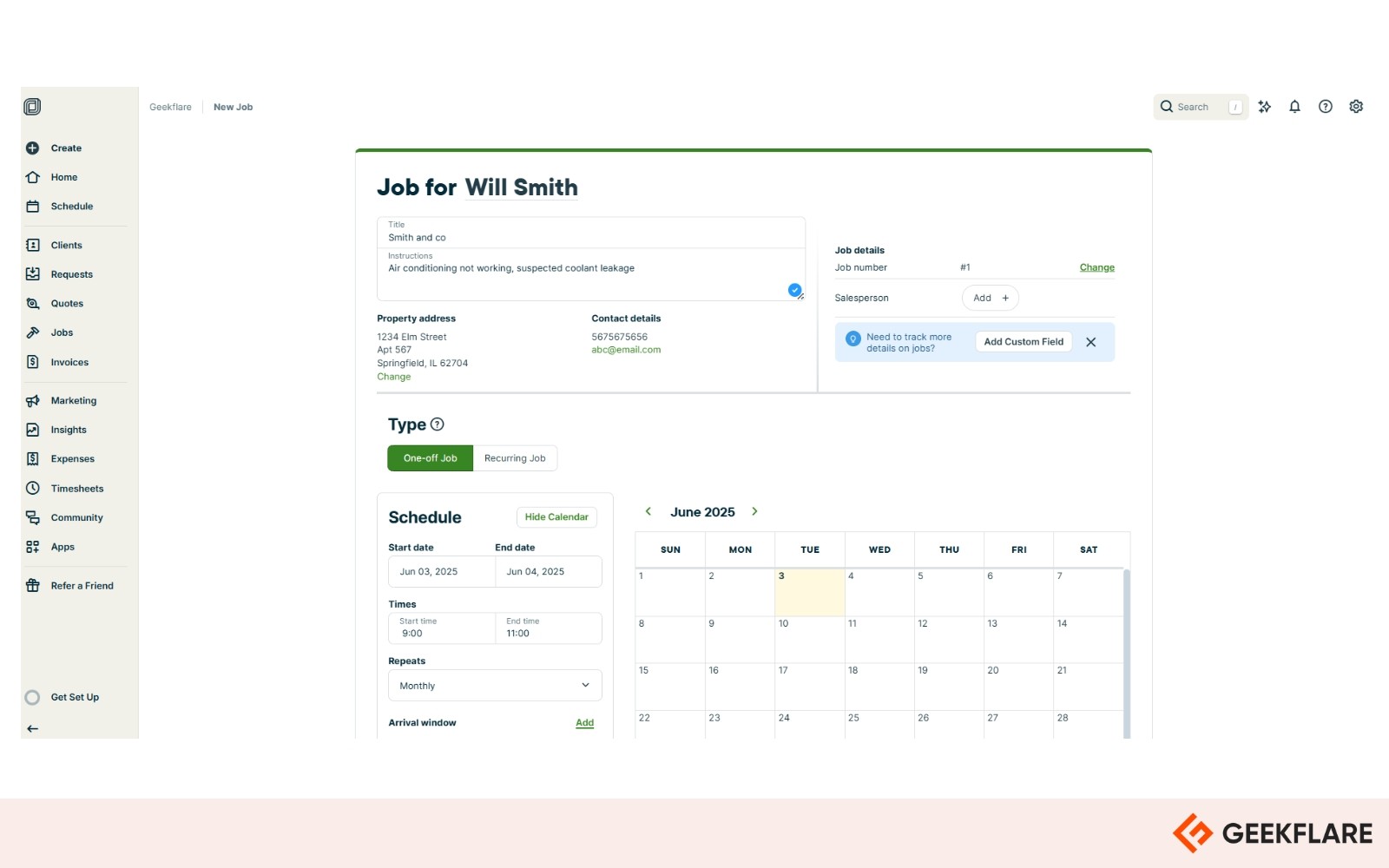
In case you get an emergency call, this dispatch software lets you quickly dispatch the nearest technician with GPS tracking while updating the schedule on the fly using drag-and-drop tools.
Jobber’s mobile app enables your team to stay in the loop, where they can check job details and client history from their phone. It also comes with built-in tools for invoicing, recurring billing, and customer relationship management.
Pros
Free trial available.
Integrates with 65+ apps.
Phone, email, and chat support for all plans.
Cons
Inventory management facility is not available.
Credit card payments incur extra charges.
Pricing
Jobber’s Core plan starts at $25/month/user with yearly billing.
3. ServiceTitan
Best for large-scale HVAC businesses
ServiceTitan is a smart HVAC assistant specially capable of serving commercial, residential, and construction projects.
For residential jobs, it makes your life easier with online booking, dynamic dispatching, GPS tracking, and even SMS alerts. It supports customer financing options to help you close bigger deals.
Commercial HVAC contractors will benefit from built-in job costing, customer relationship management (CRM) tools, detailed reporting, and automated service agreement features of this HVAC contractor software that assist them in making smarter decisions.
Construction firms can manage the entire project lifecycle and track progress in real-time with WIP (Work in Progress) reports.
ServiceTitan connects with popular accounting platforms to keep your finances clean and accurate. Moreover, the built-in marketing tools always keep your pipeline full.

I checked ServiceTitan’s demo and found its Dispatch Notifications feature extremely useful for HVAC businesses. It lets you customize SMS alerts with technician details, ratings, and job location. The Field Management menu offers Technician GPS Tracking, Technician Scorecard, and Route Optimization to help companies manage field teams efficiently. ServiceTitan does a great job keeping customers informed and optimizing technician routes for faster service.
Pros
Free templates for checklists and invoices.
100+ integration support.
Marketing software for lead capturing.
Cons
Lack of transparent pricing.
Does not offer any free trial.
4. FieldEdge
Best to optimize field operations
Through HVAC management automation, FieldEdge claims that their HVAC service software can save you 10+ hours every week! [3] Especially developed for heating and cooling companies, it makes scheduling a breeze with its drag-and-drop tools. You can quickly assign the right technician to the right job based on their skills and current location with the technician dispatching tool.
FieldEdge’s best part is its seamless integration with QuickBooks. Whatever your team does in the field, such as invoices or payments, it syncs automatically with the office, without any double entries or late-night accounting.
It keeps all your customer info, including service history, maintenance agreements, quotes, and equipment records in one place. So when a customer calls, you’re ready to deliver top-notch service.
FieldEdge saves you from chasing payments as the technicians can send invoices and get paid right from the job site. Moreover, its mobile CRM gives your technicians a more personalized experience with job notes, file upload, and form filling out.
Below is FieldEdge’s dispatch board, that found it great for HVAC scheduling, with a drag-and-drop interface to assign technicians to jobs visually on a timeline.
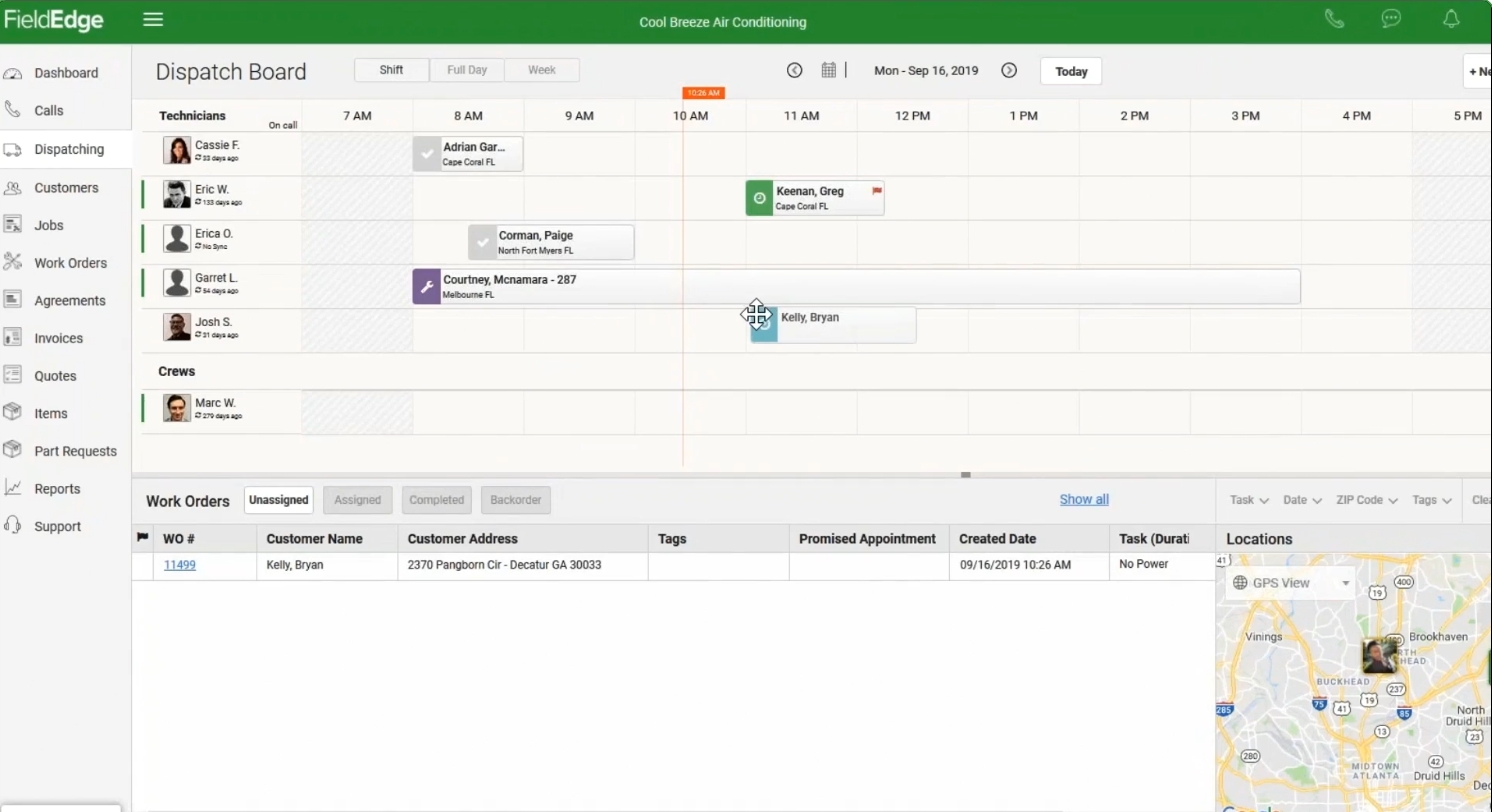
The left-side menu lets you quickly access calls, customers, jobs, work orders, invoices, and agreements, providing a full suite for managing HVAC operations. The tool also shows real-time technician locations on a map, so you can optimize routing and job assignments.
Pros
24×7 live support.
Service agreements with auto-renewal.
Android and iOS mobile app.
Cons
Inventory management is only included in Elite plan.
Select plan users don’t have access to phone support.
Pricing
FieldEdge offers 3 plans – Select, Premier and Elite. You need to contact the sales team for the exact pricing.
5. Workyard
Inbuilt GPS tracking and payroll
Workyard enables HVAC businesses to gain complete control over scheduling, dispatch, time tracking, and cost management. It offers a super intuitive Task and Schedule Board that only takes a few clicks to assign jobs by project or by technician.

As seen in the above screenshot, the left-side menu includes key sections like Projects, Timesheets, Tasks, Schedules, and Reports—allowing you to oversee your HVAC team’s schedules and performance. The tool also supports detailed task tracking with options for due dates, recurrence, status, labels, checklists, and team assignments
You can even set up its CRM to auto-create tasks when the job is ready. It lets you add custom labels to make things fit your workflow. In case of urgent calls, Workyard’s real-time location tracking helps you make smarter, faster dispatching decisions.
Workyard enables techs in the field to stay in the loop. They can take a photo or jot a note from the job site instantly to send a job update. Its time card feature supports clear billing by displaying how many hours were worked, on what job, and under which cost code.

On Workyard, time tracking for field teams becomes automated with a GPS-powered time clock and facial recognition. I personally like how its reporting feature helps you identify and improve attendance issues. It also tracks real-time job costs and identifies if you are overestimating or underestimating.
Pros
14-day free trial.
Audit trail with GPS verified time log and change log.
Geofencing and mileage tracking.
Cons
Limited number of integration support.
Invoicing feature is not available.
Pricing
Workyard charges you $6/user, but you need to pay a $50 base fee.
6. Service Fusion
Integrated field service management
Service Fusion promises to increase your team productivity by 40% with its all-in-one solution tailored for HVAC businesses [4]. Its key features include drag-and-drop scheduling, mobile dispatching, and complete job site visibility.
Pre-populated product and service line items allow you to create job estimates for sharing with your customers and convert them into jobs with one click. For customer management, you get features such as automated text notifications, a web booking portal, and two-way communication via ServiceCall.ai.
Service Fusion keeps your workforce connected, and lets you accept on-site payments using a Stripe mobile card reader, integration with QuickBooks, and a secure payment platform named FusionPay.
You get enhanced operational visibility with fleet tracking and speed up agreement closures with eSign, and reduce paperwork with mobile-first job and note logging.
Pros
Flat pricing for unlimited users.
Ideal for companies with large teams.
Open API Integration.
Cons
Does not offer live chat support.
Customer web portal is only available for Pro plan users.
Pricing
Service Fusion costs you $192/month for an unlimited number of users.
7. Zuper
Flexible FSM for small businesses
Zuper lets you professionally handle residential repairs, commercial HVAC jobs, or emergency calls through its flexible work order management system and handy mobile app. Your technicians can check job history, stay updated with assigned tasks, and follow custom checklists to deliver top-notch services.

It supports HVAC team coordination by allowing technicians to collaborate with the office staff in real-time with job notes and built-in chat. Zuper’s smart scheduling system and intelligent dispatching features let you prioritize jobs based on skillsets, location, and availability when you need to juggle multiple appointments.
Thanks to Stripe integration, your mobile workforce can send quotes and invoices from their technician app and receive payments from customers both online and offline. With QuickBooks and Zoho Books integration, your accounting stays accurate and up-to-date.
Zuper also offers 50+ detailed reports and an easy-to-read dashboard to track performance and gather customer feedback in one place. Additional highlighted features include location intelligence, contract and inventory tracking, and asset management.
Pros
60+ third-party app integration.
Offers a collection of APIs.
24/5 customer support for all users.
Cons
Additional one-time setup fees.
Does not support monthly billing.
Pricing
The subscription plans for Zuper start at $65/user/month.
8. FieldPulse
Residential HVAC software
FieldPulse is highly beneficial for managing residential HVAC projects, contributing to 78% average growth year-over-year and 89% average increase in revenue. Its Website Integration Booking Portal allows you to receive service requests directly from your customers through your website.
Scheduling and dispatching are both super simple on this platform. You can quickly assign jobs and optimize routes to save time and fuel costs. Its live GPS tracking, and team views let you see who’s where and doing what.
FieldPulse also helps with job and project management with real-time job progress, specific task assignment, milestone tracking, and key documents or photos upload. It provides built-in financial dashboards, reporting, and cost tracking, to let you spot trends and get financial insights.
FieldPulse Engage, the built-in CRM and communication tool, enables you to stay in touch with your customers by call, text, or email. You can use its preset pricing to quickly generate professional-looking estimates, customize it if needed, and automatically create an invoice when the job is done.
Pros
Ideal for residential HVAC projects.
HVAC Workflow automation.
Built-in communication tools for teams.
Cons
Transparent pricing is not available.
Fleet tracking comes as an add-on.
9. Zoho FSM
Affordable HVAC software for small teams
Zoho FSM simplifies scheduling and dispatching with customer communication tools for HVAC without breaking your bank. Create and manage work orders, assign jobs based on technician availability and skill, and track progress in real time. Its mobile app provides technicians with job details, checklists, and instructions for maximum efficiency in the field.
Using this platform, you can automatically update your customers, share detailed service reports, and collect feedback via email, SMS, or WhatsApp. It allows customers to submit service requests through web forms, eliminating back-and-forth calls.
Zoho FSM is also ideal for financial operations with estimation generation, multi-currency invoicing, invoice tracking, region-specific tax settings, and integrated payment options. Its built-in dashboards and reports offer real-time insights into performance, operations, and team productivity.
I tried Zoho FSM and found the Dispatch Console with Gantt view useful for visualizing HVAC technician schedules across multiple days. The Work Order Management menu lets you manage all HVAC service requests, while Billing and Services and Parts help handle invoicing and inventory—both critical for HVAC operations.
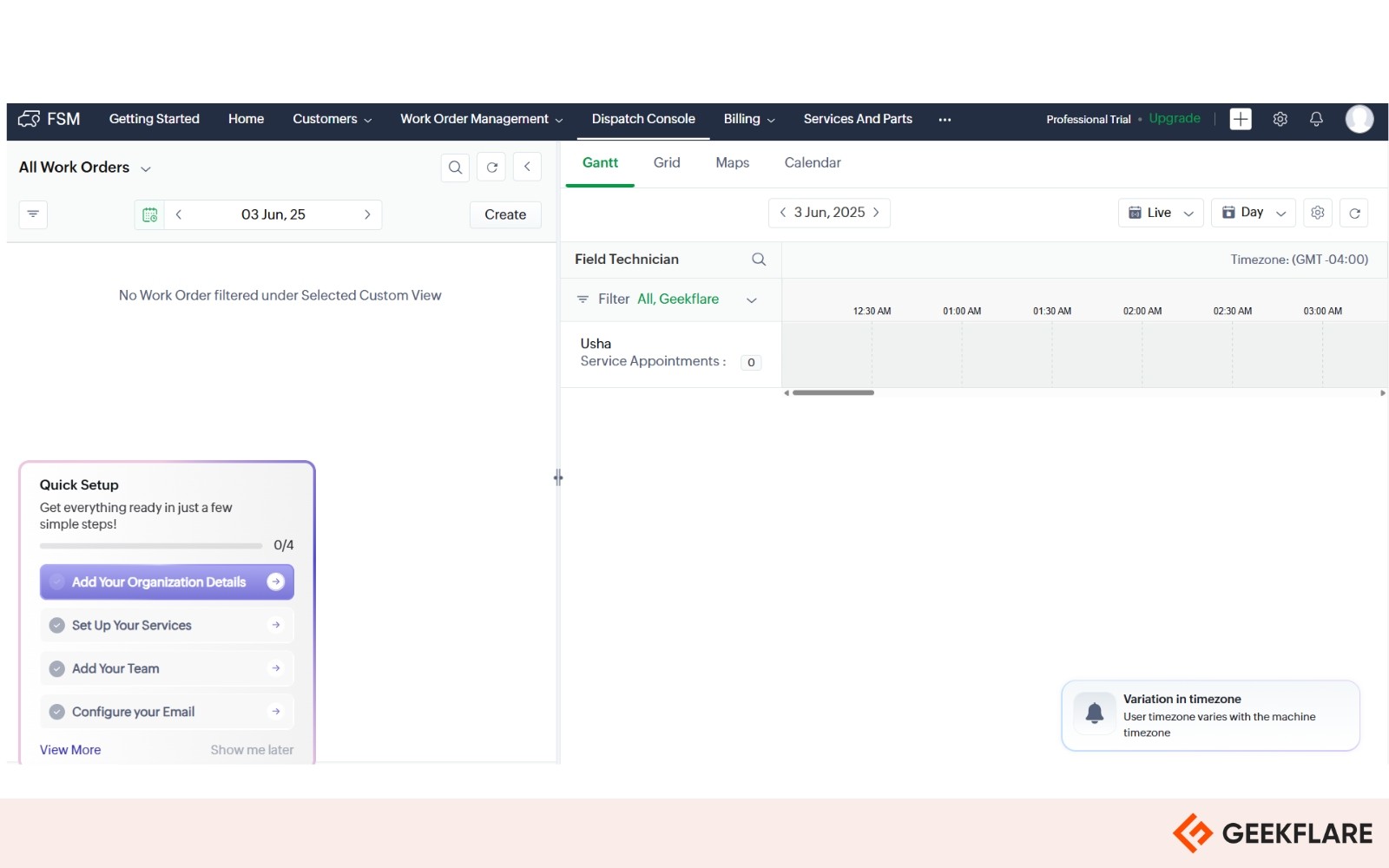
The left panel features Quick Setup steps like adding organization details, team, and services. Your front-desk teams can manage customer profiles, monitor request stages, and access service history instantly. It also offers a range of automation tools for custom workflows, field updates, and webhooks to reduce manual work while maintaining accurate data across systems.
Pros
Service update and assistance via WhatsApp.
Supports multi-day project management.
Free plan available.
Cons
No QuickBooks integration.
Free plan supports up to 20 users.
Pricing
Zoho FSM has a free plan, but its pricing tier starts from $25/user/month.
Beyond Top Picks of HVAC Software
Here are some additional HVAC applications that you might want to try.
10. Field Complete: Built by contractors
Field Complete is a cloud software that works on mobile devices and tablets. It helps with work scheduling, calculating job estimation, browsing inventories, creating invoices, GPS tracking, and receiving on-site payments. Its free plan is available for up to 10 users.
11. Podium: AI-powered customer interactions
Podium is not directly an HVAC software, but it helps HVAC companies by managing leads and customer interactions. It lets you automate repetitive tasks such as sending review invites, follow-ups, and payment reminders, while enabling you to make and receive calls on your mobile app.
12. Connecteam: To improve daily operations and team management
Using Connecteam, you get features such as technician utilization and time-to-completion overview, digital timesheets, service ticket information, digital reports, and checklists. It enables your technicians to contact clients through the app without saving their information.
13. Simpro: Job management platform to optimize HVAC projects
Simpro is an end-to-end FSM software for asset tracking, project management, HVAC billing and quoting, customer management, and reporting. It also comes with enterprise-level support and inventory tracking facilities.
14. ServiceFolder: Best for individual contractors
Powered by QuickBooks integration support, ServiceFolder can create invoices and accept payments within minutes without double efforts. Additional features include equipment tracking, creating and sending estimations, sorting work orders, and managing customer details.
15. ServiceTrade: Inbuilt sales and project management tools
ServiceTrade lets you schedule preventive maintenance management and emergency repairs efficiently while tracking labor and materials for accurate job costing. Besides, it assists you in maintaining operations, service sales, project management, and parts management.
How to Choose the Right HVAC Software
Identify your core needs for HVAC software. You must clearly understand what your business requires — scheduling, invoicing, dispatching, customer management, or GPS tracking.
Once you know the features you want to see in your HVAC software, the following are the factors you should consider while choosing an HVAC software.
- Business size: Choose software that is suitable for your team size and workload. Also, look for scalable software if you have a growing company.
- Type of work: Make sure to select an application that supports the specific workflows and compliance needs of the projects you handle, be it residential, commercial, or mixed projects.
- Specific services offered: Look for tools that cater to your core offerings, such as installation tracking or routine maintenance scheduling.
- Budget constraints and expected ROI: Select software that fits your budget while improving efficiency and customer satisfaction.
How We Selected the Top HVAC Software
At Geekflare, we took a thoughtful and practical approach to put together our list of top HVAC software. We have gone through the user reviews on trusted sites to see which HVAC software worked and which didn’t. We also compared the features side by side, focusing on those that really matter to keep the business running smoothly, such as scheduling, invoicing, dispatching, and mobile access.
We paid close attention to how well each software is trusted in the HVAC world. Reliability and brand reputation matter when you’re picking a tool your whole team will depend on. Not to mention, we looked at pricing, customer support and scalability before recommending tools that will actually make life easier out in the field.
Frequently Asked Questions (FAQs) about HVAC Software
HVAC software typically costs $25-$65. Many HVAC software offer custom pricing depending on the number of users and features you choose to have, so you need to contact them to know the quote for your company.
Jobber and Zoho FSM are cheap because both the HVAC software costs $25/user, with Zoho FSM having a free plan. Apart from these, Workyard is also cheap for medium and large teams because it costs a $50 base fee and $6/user.
No, HVAC software is not difficult to learn. Depending on the software you use, you should be able to master it within a few days.
Yes, HVAC software can help you get more customers with automated scheduling and follow-ups, quick response time, and GPS tracking. It enhances customer satisfaction and supports targeted marketing with features like CRM, quote generation, and service reminders.
References
-
 EditorUsha, the editor-in-chief of Geekflare, is a tech-savvy and experienced marketer with a Master’s degree in Computer Applications. She has over a decade of experience in the tech industry, starting as a software engineer and then moving into digital marketing and team management.
EditorUsha, the editor-in-chief of Geekflare, is a tech-savvy and experienced marketer with a Master’s degree in Computer Applications. She has over a decade of experience in the tech industry, starting as a software engineer and then moving into digital marketing and team management.

